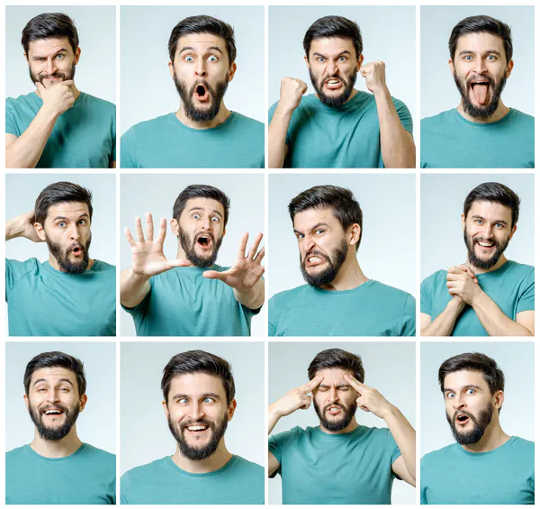
Vergani Fotografia/Shutterstock
There’s a good chance that you when you leave the house today you’ll put on a face mask that obscures your mouth. Such coverings can affect our ability to communicate and provides a particular challenge to those that need to see lips to understand speech.
But what of the eyes that remain uncovered? Shakespeare said the eyes were the windows to the soul. I’m not sure about “souls”, but it’s very clear that eyes can provide a great deal of information.
It’s why poker players sometimes wear dark glasses because of a fear of giving away a “tell”, a tiny almost imperceptible cue to other players that they are holding a good hand, or bluffing. This might be common wisdom, but there is also some science that supports this.
Our emotions are how we understand others and how they understand us. And research has found that it is possible to interpret people’s emotions by analysing their eyes. In 2017, researchers at Cornell University showed volunteers images of eyes expressing different emotions: sadness, disgust, anger, joy, surprise or fear.
The participants were able to consistently rate how well different words describing mental states matched the “eye expression”. The researchers concluded that the eyes provide essential interpersonal insight, and that different aspects of the eyes (such as how open they are or how sloped the brow is) give information about different mental states.
The neuroscience is also interesting here. We know humans are exceptionally sensitive to very tiny changes in direction of gaze. When you are trying to judge which direction someone is looking in, it significantly activates your amygdala, a part of the brain we have long known to be associated with emotion. This shows there is a link between emotion and eyes at a neurological level.
We know that the amygdala is relevant in all things to do with emotion, and it is best known for its role in fear and its mediation of the “fight or flight” response. Further research has shown that the amygdala is also active when we are monitoring the scene for events where a person may be looking in our direction, or changing their direction of gaze.
This could indicate the importance of the eyes in finding a mate, expressing interest in others, or perhaps conversely in identifying threats from others. In short, we are wired to extract information from the eyes – information that can help us assess the emotions of those around us and so allow us to engage more effectively with them.
 Eyes help us understand emotions. Iurii Stepanov/Shutterstock
Eyes help us understand emotions. Iurii Stepanov/Shutterstock
There is further evidence of the importance of the eyes from neurochemistry. We know that oxytocin, a naturally produced hormone, is important in social interactions and that it may be important in how we perceive the faces of those around us.
Researchers have found that, when shown images of faces, people who are given oxytocin spend more time looking at the eyes than those given a placebo. Since oxytocin is a factor in social interactions, this finding suggests the eyes are very important in how we understand our engagement and interaction with those around us. Those with elevated levels of oxytocin appear to seek out the eyes to help them better engage socially with others.
For the dog-lovers among us, there’s also some research that suggests that when dogs and their owners look into each other’s eyes, oxytocin levels increase in both the humans and the pets, suggesting an increased social bond. This only seems to happen with domesticated dogs with whom a close social bond is important to the owners and their animals, the results are not shown with wolves.
Eye don’t believe it
There are, however, some things that the eyes can’t tell us. There is one rather sticky myth that comes from so-called “neurolinguistic programming” (NLP), the approach often favoured by those who like to claim you can use psychology to achieve an advantage over others.
The theory goes that if someone is looking up and to the right when they are talking then that somehow indicates that they are lying. But when researchers filmed a group of people telling true and false stories, and then asked another group to try to spot the lies by looking at the speakers’ eyes, they found no evidence for a link between lying and eye movements at all.
If you want to know what someone is feeling when face coverings are the norm, the eyes may well have the answer you are looking for. We can definitely tell if people are smiling by looking at their eyes, and a smile is so very important, now more than ever.![]()
The eyes have it @holburne ???? #EnjoySummerSafely #RediscoverBath #LoveCultureWeek pic.twitter.com/xXmrkQLKAL
— The Holburne Museum (@Holburne) August 21, 2020
About the Author
Nigel Holt, Professor of Psychology, Aberystwyth University
This article is republished from The Conversation under a Creative Commons license. Read the original article.

Related Books:
Crucial Conversations Tools for Talking When Stakes Are High, Second Edition
by Kerry Patterson, Joseph Grenny, et al.
The long paragraph description goes here.Click for more info or to order
Never Split the Difference: Negotiating As If Your Life Depended On It
by Chris Voss and Tahl Raz
The long paragraph description goes here.Click for more info or to order
Crucial Conversations: Tools for Talking When Stakes Are High
by Kerry Patterson, Joseph Grenny, et al.
The long paragraph description goes here.Click for more info or to order
Talking to Strangers: What We Should Know About the People We Don't Know
by Malcolm Gladwell
The long paragraph description goes here.Click for more info or to order
Difficult Conversations: How to Discuss What Matters Most
by Douglas Stone, Bruce Patton, et al.
The long paragraph description goes here.
























